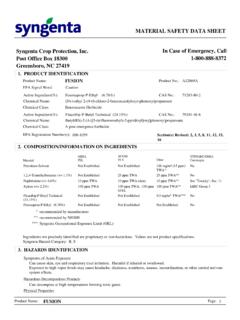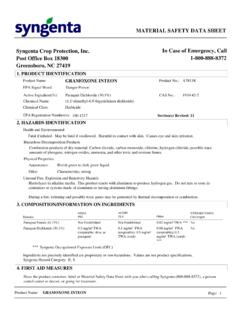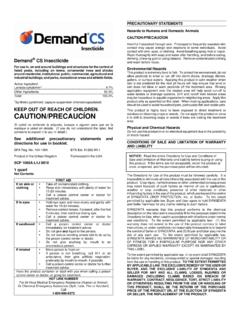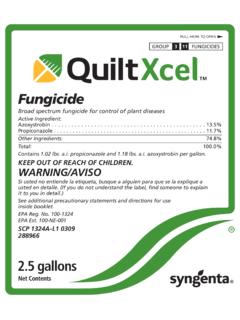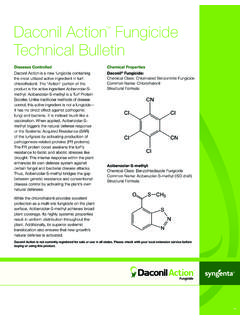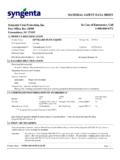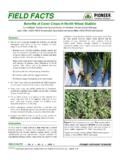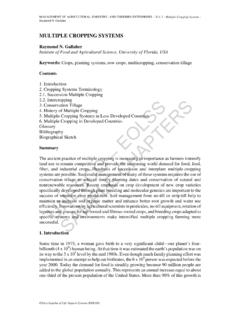Transcription of A Guide to Best Management Practices - Syngenta
1 Cereal Stand EstablishmentA Guide to Best Management PracticesBack to the Basics:Cereal Stand EstablishmentPRODUCTION BASICS ARE EVOLVING AT AN ACCELERATED PACEC ereals, like wheat and barley, are a common staple on Prairie farms because of their excellent fit with our climate, our soils and crop rotation Practices . Generations of cereal growers have amassed an unparalleled depth of experience in how to growthese crops such a long history and breadth of skills and knowledge in growing cereals,stand establishment Practices may sometimes be taken for granted or are two reasons why we need to get back to the basics when it comes to bestmanagement Practices for cereal stand cereal crops, individual growers have a much greater responsibility for ensuringseed quality. Because the use of common or bin-run seed is the normal practice for many growers,they take ownership of issues such as germination, emergenceand The landscape of cereal production has changed considerably over the years.
2 Newproduction techniques and agronomic challenges make this a good time to revisitbest Management Practices for cereal crops to ensure that what we re doing in the field is keeping up with the times. These changes include:nFarming larger areas with less labour:less time to get everything done,especially on more and more acres with lesser-known Management tillage:has rapidly increased in the last decade alone, creating fieldenvironments that may be more conducive to disease and insect survival, andleaving cooler soils for introduction of higher yielding varieties:new crosses may requirechanges in production Practices to reap the full out of some traditional seed treatments:lindane treatments are gone,and new seed treatments bring more to the table in terms of insect anddisease seeding:seeding early to maximize crop competition and lengthen thegrowing season window can also increase pressure from seed- and soil-bornedisease and early season insects.
3 NFaster seeding with bigger machinery:small misjudgments at seeding time can mean big problems later weeds:the presence of herbicide resistant weeds is increasing ineconomic importance to cereal growers. These factors can impact every element of production from rotations to varietyselection to fertility plans to seed treatment choice to pest scouting and more. Athoughtful re-examination of how we manage and handle cereal crops at seeding time can help us all better achieve robust, uniform stands that are better able to face early season challenges such as seedling diseases or weed competition. And with a well-established, competitive crop you are much more likely to get the yields,quality, harvestability and rotational advantages you re aiming Cereal Stand Establishment Guide examines the production Practices that canhave an impact on early season cereal crop success.
4 The Guide outlines the bestmanagement Practices in three main areas of stand establishment:nseeding practicesndisease managementninsect managementAt the back,you ll also find a list of references where you can get further informationon cereal production, a field scouting Guide to help you more accurately assess earlyseason disease risk, and an at-a-glance risk assessment Guide to help you make seed treatment and seeding Syngenta , we re committed to helping you grow the best cereal crops. Use thisguide to help build an integrated cereal Management plan that works best for your That Affect CerealStand EstablishmentAchieving strong stand establishment is the result of an integrated crop managementplan that focuses on maximizing those factors that help young seedlings survive andsucceed, and minimizing those that can set them back. Best Management Practices for cereal stand establishment centre around three mainthemes: seeding Practices , disease Management and insect Management .
5 Within thesethree main groups, there are many factors that can affect cereal stand quality (germination, vigour) rate and and soil-borne competitionOf course, growers can t control the weather. But they can exercise influence over all the other factors on this list,and when they do that, they do much to buffer theeffects of weather on a young truly integrated cereal stand establishment Management plan recognizes that whencereal seedlings are weakened by one of the above factors, the effects of the othersare magnified. For example, even mildly diseased seed will struggle to emerge andgrow rapidly. The effect of weed competition or frost on a struggling plant like this aremuch more severe than on the same seed that was treated with a fungicidal seedtreatment. Seeding too deep or into an ill-prepared seedbed can also leave plantsstruggling to catch up.
6 All factors need to be taken into account when making yourseeding they re well executed, basic, proper seeding Practices can have a huge impact on whether or not a healthy, competitive cereal crop emerges and establishes itself in the Management starts with taking ownership of the seed qualitychoices available. Buying Certified cereal seed remains an excellent managementchoice, especially for newer varieties of wheat and barley, because certificationguarantees seed quality in terms of germination and varietal purity. But the typical practice is to use one s own common wheat and barley seed. In thiscase,growers should always have their seed tested at an accredited seed lab forgermination,vigour and the presence of seed-borne diseases consider it part of your input costs. It s usually not enough to simply clean up seed from a crop that grew well last year, or to rely on a home germination test.
7 Sprouting in a home testdoes not necessarily mean the seed has sufficient vigour to perform well whenseeded in difficult conditions such as cold soils, or soils with elevated levels of soil-borne diseases or insects, such as previous year s seed storage conditions must be considered,too. Seed lab testresults on many samples from the 2004 crop year indicate extensive cereal seeddamage as the result of a late harvest in difficult weather conditions, including many cases,a rushed harvest meant crops were binned before they werecompletely stable, meaning that seed that germinates well in a fall test may have a significant decrease in germination by the time it s used in the spring. A variety of moulds can also attack seed that is damaged or stored without proper drying oraeration. Treating seed early can be a good Management strategy to prevent qualityloss to moulds during storage, but be cautious of how long you store the treatedseed.
8 Some seed treatments can cause loss of germination if stored for too long,so be sure to check product labels for proper storage records of pre-harvest glyphosate applications are also essential to evaluatingseed quality. If you cannot reliably recall which cereal fields received a pre-harvestglyphosate treatment, it becomes even more essential to test the quality of commonseed to ensure there has been no impact on quality is one of the most critical factors in cereal stand establishment. The highuse of common seed means seed quality in any given year is all over the map. Alwayshave your seed tested at an accredited seed lab, or buy quality-tested Certified of the most common causes of seed failing to germinateproperly is poor seed-to-soil contact, which comes down to seedbed the seedbed properly is a challenge, particularly with minimum or zero-tillsystems stubble and surface trash help preserve moisture, but it can also makeproper seed-to-soil contact difficult.
9 As much as possible, the seedbed should belevel, uniform, well packed and warm (5 C or higher), with the previous crop s residuewell spread at harvest or by harrowing. Clumps of chaff or straw will certainly reduceor delay stand s larger seeding equipment means more acres can be seeded in less time. Butsince most farms are now also much larger, often with widely separated parcels ofland, there is still as much or more pressure to finish seeding in the time available,or extend operations into the night, when it s harder to monitor conditions. Thesepressures can also lead to increasing tractor speed during seeding operations. It simportant to remember that seeding at too high a speed can result in uneven seedand fertilizer placement and could reduce seed-to-soil contact. A conscientious effortduring seeding operations will result in improved, even germination and contribute to optimal stand early is a good practice,but seeding too early can meandelayed or reduced emergence due to cold weather conditions; and cold soils, whethermoist or dry, are not conducive to rapid germination and emergence.
10 This kind of delay leaves the crop vulnerable to disease and insect attack for a longer than normalperiod of time. Picking the right date is always difficult because no one knows whatMother Nature will do, but exerting influence over seeding Practices (like properrotations, seed quality, the seeding operation itself and use of seed treatments) cangive early-seeded crops a better chance at becoming established even if early seasonweather turns seeding rates will vary with new varieties,different soil types,fertilizer use and target yields. That s why the old rules of thumb may not be asreliable as they once were. Reduced seeding rates leave no margin for error in theevent of unexpected pressures, such as spring frost or heavy weed competition,and can lead to significant yield and quality losses. One advantage with cereal cropsis the lower cost of good quality seed compared to crops such as peas or canola,so recommended cereal seeding rates can be maintained without incurring additional expense.

